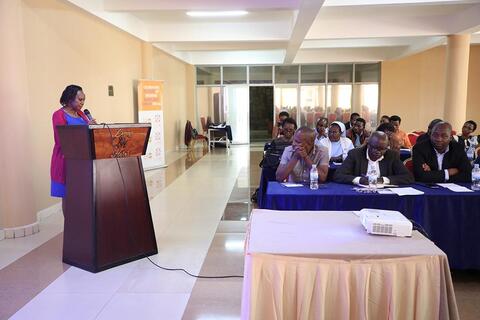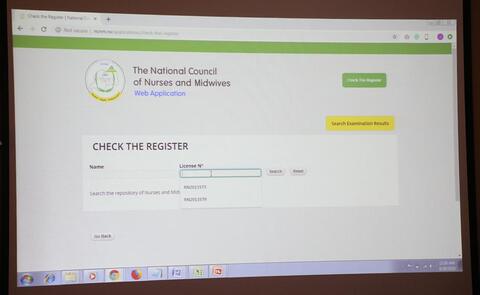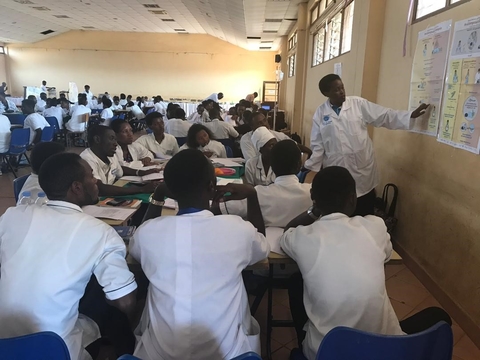By Mathias Gakwerere, UNFPA Rwanda Maternal Health & Midwifery Program Officer
Years of work in maternal health culminated in a week full of key highlights in midwifery. To start with, the International Confederation of Midwives (ICM) celebrated the release of a new UNFPA Global Strategic Plan at their Africa Region Conference. This was just a few days after the release of the much anticipated web-based application by UNFPA and the National Council for Nurses and Midwives (NCNM) in Rwanda, aimed at making training, licensing and monitoring easy, accessible and available to all. It was also the week when the NCNM celebrated their 10 year anniversary.

The new global midwifery strategy has three new pillars of midwifery namely midwifery workforce, enabling environment, and to have midwives recognized as being at the center of SRH service provision. These new pillars complement the already existing pillars: education, association and regulation. The strategy calls for a renewed partnership among stakeholders to ensure its implementation given that midwives remain at the forefront towards achieving the Sustainable Development Goals (SDGs) targets on maternal, neonatal, child and adolescent health.
The overall goal is simple and cannot be compromised on: “No woman should die while giving life”.
Rwanda has made great achievements on this, being one of only nine developing countries to meet the Millenium Development Goals for reducing maternal deaths. The reason we are able to achieve so much progress is that we are working together in strong partnerships and making sure to bring in new partners at every level, including the government, broadening our resources and learning new approaches.
The web application is a perfect example of this: UNFPA partnered with NCNM to innovate beyond the traditional pen and paper system, meaning no more queues at the office for licence applications or re-licensing, and monitoring the Continuous Professional Development by nurses and midwives required every year thereby streamlining the process and benefiting everyone involved.

I was invited to explain this new development at ICM Africa Regional Conference and during the pre-conferences, both taking place in Windhoek, Namibia from the 11th to the 14th of September 2019 - the meetings brought together practitioners as well as partners, new and old. It was an amazing start to several days of collaboration that addressed a number of other new developments and innovations in midwifery, such an expansion of the use of Mobile Learning System (MLS), a user-friendly and portable, cost-effective training solution, highly adapted to rural and hard-to-reach areas relevant for both pre-and in service midwives. I also spoke about the impact of using e-learning in midwifery training institutions for both tutors and midwives students to over 100 attendees.
It has been incredibly exciting learning from each other as many countries are leading in various innovative ways. It was inspiring to listen to colleagues from Kenya with Amref International University, who shared their experience with a simple phone application used to address knowledge gaps among pregnant women, teaching them about the danger signs and giving reminders for their next antenatal consultation visits. Their project is called Sustainable Solutions for Midwives Education and Employment (KISSMEE).
We saw new medical equipment like the Moyo fetal health rate monitor, exhibited by Laerdal company, which facilitates intermittent and prolonged fetal heart rate monitoring, enabling timely decision making after detection of abnormal fetal heart rates. Scientific research on the effectiveness of some alternative solutions to prevent bleeding after birth, the leading cause of maternal deaths across the globe, was also discussed. The World Health Organization (WHO) has recommended expanding usage of Carbetocin, a heat stable oxytocin analogue, that works as a good alternative particularly in facilities with unreliable cold chain. This is particularly important given that storing the commonly used drug form of oxytocin, Pitocin, requires reliable cold chains yet not all facilities in developing countries have them. This is why I strongly support the recommendation by the WHO.

Since the beginning of my medical studies two decades ago, I have witnessed the tragedies of maternal and neonatal deaths in clinical settings and I started asking myself what could be my contribution to address this global public health issue. Working with nurses and midwives has been an answer: if you provide them with the needed support, you see a drastic reduction in maternal and neonatal deaths because they are at the forefront in every facility, rural and urban.
Midwives will continue to lead the way for quality and equity towards the goal of reaching zero preventable maternal deaths by 2030.


